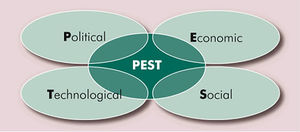PEST analysis
| PEST analysis |
|---|
| See also |
PEST analysis is one of the most popular and simple method for strategic analysis of organization’s macro environment containing four group of factors: Political, Economic, Social and Technological.
Macro environment has a significant effect on business entities’ activities, but most importantly these forces and factors are independent from activities of company and its management. Due to increasing rate of change in environment management has to continuously monitor, identify and observe trends of all important factors influencing its strategy.
PEST analysis factors
- Political - first step of a PEST analysis is a study of political factors which could create plenty of advantages and opportunities for organizations. These factors include: political situation, political stability, state legislation, market regulations, state interference, trade agreements, tariffs or restrictions, taxes, lobbying and clarity of law, and other legal factors affecting business.
See more examples of Political factors affecting business
- Economical - second step of PEST analysis is focused on economic factors. Interest rates and fiscal policy creates overall economic conditions, influencing purchasing power of consumers and structure of their expenditure. These factors include: gross domestic product (GDP), demand, stock market, currency rate fluctuations, rate of inflations, market substitutes, complementary products, tax policy, commodity price changes, revenues and savings of consumers and level of unemployment.
See more examples of Economic factors affecting business
- Social - third step of a PEST analysis concentrates around society. Social forces influence consumer's attitudes, interests, opinions, behaviour and ultimately purchase decisions. Changes in trends have direct impact on enterprises. These factors contain: demography, structure of population, rates of increase/decrease, competition, traditions, level of education, cultural diversity and values, ethics, religion, fashion, social group pressures.
See more examples of Social and cultural factors affecting business
- Technological - fourth step of PEST analysis involves technology. Technological advances have greatly changed the manner in which businesses operate. Nowadays technological and scientific progress in developing society is getting faster and leads to new products, services and consumer needs and expectations. These factors include: new production technologies, absorptive capacity for innovation, globalization in communication. New technologies shorten product life cycle and increase demand for new products. Technological revolution has also increased the rate at which information is exchanged between companies, suppliers, consumers and other stakeholders and it forces companies to increase speed of response to changes in technology and market conditions.
See more examples of Technological factors affecting business.
Above mentioned external environment factors, can have both positive influence (then they are called opportunities) or negative influence (and then they are called threats). Theory and practice of management science led to the development of many variants of strategic external environment analysis. Most notable and worth mentioning are: PESTEL analysis, PESTLE analysis, PESTLED analysis, STEEP analysis, STEPLE and STEEPLE analysis.
References
- Bowman, C. (1998). Strategy in practice (p. 201). Prentice Hall Europe.
- Burt, G., Wright, G., Bradfield, R., Cairns, G., & Van Der Heijden, K. (2006). The role of scenario planning in exploring the environment in view of the limitations of PEST and its derivatives. International Studies of Management & Organization, 36(3), 50-76.
- Carruthers, H. (2009). Using PEST analysis to improve business performance. In Practice (0263841X), 31(1).
- Koumparoulis, D. N. (2013). PEST Analysis: The case of E-shop. International Journal of Economy, Management and Social Sciences, 2(2), 31-36.
- Peng, G. C. A., & Nunes, M. B. (2007, July). Using PEST analysis as a tool for refining and focusing contexts for information systems research. In 6th European conference on research methodology for business and management studies, Lisbon, Portugal (p. 229-236).
- Pearce, J. A., Robinson, R. B., & Subramanian, R. (2000). Strategic management: Formulation, implementation, and control. Columbus, OH: Irwin/McGraw-Hill.
Author: Weronika Winkowska
